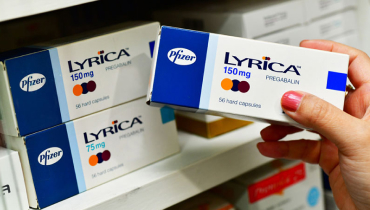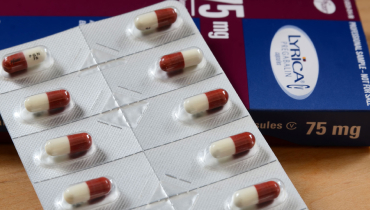Neuropathic pain (NeP) is a challenge for treating physicians [1]. Problems in its treatment can be related to various factors. The signs and symptoms of this pain are not constant; their combinations may vary from patient to patient. Not all patients are able to describe their pain well using descriptors specific to neuropathic pain syndrome, which can lead to misdiagnosis, especially by general practitioners who see the majority of patients with neuropathic pain. A complex clinical picture can lead to ineffective prescribing, inappropriate dosing, and therefore few patients are able to completely control the pain syndrome. Statistics show that many of the patients with NEB are in pain for a long time, with about 80% of patients experiencing pain for more than a year before their first visit to a specialist.
Another factor is the wrong choice of medication. A key characteristic of neuropathic pain is that it responds poorly to traditional pain medications such as nonsteroidal anti-inflammatory drugs (NSAIDs).
Antiepileptic drugs and antidepressants are considered the most effective drugs for treating neuropathic pain. However, practice and special studies show that antiepileptic drugs and antidepressants make up only a small portion of all physician prescriptions (13% and 8%, respectively) made worldwide for the treatment of neuropathic pain. While NSAIDs for neuropathic pain are prescribed in 41% of cases and simple analgesics in 21%. Thus, more than 60% of patients with neuropathic pain receive inadequate pharmacotherapy.
Nevertheless, significant progress has been made in recent years in understanding the mechanisms of neuropathic pain and new possibilities for its effective pharmacotherapy have emerged.

Clinical characteristics and prevalence of neuropathic pain
Pathophysiology is used to distinguish between nociceptive and neuropathic pain. Nociceptive pain is pain caused by the action of a factor (mechanical trauma, burn, inflammation, etc.) on peripheral pain receptors, when all parts of the nervous system are intact. Neuropathic pain refers to pain caused by an organic lesion of various parts of the nervous system involved in pain control. The proposed separation of two types of pain is important primarily from a practical point of view. While simple, combined analgesics and NSAIDs are effective in treating nociceptive pain, these agents are ineffective or ineffective for neuropathic pain. Adequate therapy of neuropathic pain syndromes is possible with the use of primarily anticonvulsants.
In the population, neuropathic pain occurs in up to 8% of cases. Today, neuropathic pain includes a whole group of chronic pain syndromes arising from both peripheral and central nervous system disorders (Table 1). This group includes pain syndrome in various mononeuropathies and polyneuropathies. Among these, pain is most common in diabetic and alcoholic polyneuropathies (25-45%). Postherpetic neuralgia (this complication occurs in 70% of cases of herpes zoster in the elderly) is also a variant of NeB. Neuropathic forms of pain syndrome include complex regional pain syndrome (CRPS) (local pain with edema, trophic disorders and osteoporosis). Neuralgia of the trigeminal nerve, phantom pain, post-stroke central pain, pain syndrome in multiple sclerosis, syringomyelia, spinal cord lesions are typical examples of neuropathic pain. According to various authors, NeB occurs: in diabetic polyneuropathy – up to 45%, multiple sclerosis – 28%, syringomyelia – 75%, cerebral stroke – 8%, nerve trauma – 5%. Among all patients with neuropathy, patients with diabetic polyneuropathy, radiculopathy, and postherpetic neuralgia account for the majority (about 50%).
Neuropathic pain syndromes
Peripheral neuropathic pain:
- Diabetic polyneuropathy
- Alcoholic polyneuropathy
- Acute and chronic inflammatory demyelinating polyneuropathies
- Alimentary-conditioned polyneuropathies
- Idiopathic sensory neuropathy
- Nerve compression or infiltration by a tumor
- Phantom pain
- Postherpetic neuralgia
- Trigeminal neuralgia
- HIV-related sensory neuropathies
- Tunnel neuropathies
- Radiculopathies (cervical, lumbosacral)
- Pain after mastectomy
- Postradiation plexopathy
- Complex regional pain syndrome
Central neuropathic pain:
- Compression myelopathy with spinal canal stenosis
- Postradiation myelopathy
- Vascular myelopathy
- HIV myelopathy
- Spinal cord injury
- Post-stroke pain
- Pain from multiple sclerosis
- Parkinson’s disease pain
- Syringomyelia
- Lateral brainstem stroke
Nociceptive pain is more often acute in its development, whereas neuropathic pain is predominantly chronic. In certain cases, there is a combination of nociceptive and neuropathic pain components (in compression radiculopathies, cancer pain, tunnel syndromes).
NeB has its own characteristic differences. First of all, it is a complex of specific sensory disorders, which can be divided into two groups. On the one hand these are positive symptoms (spontaneous pain, allodynia, hyperalgesia, dysesthesia, paresthesia), on the other – negative symptoms (hypoesthesia, hypalgesia). Neuropathic pain is characterized by a combination of sensory positive and negative symptoms, which may vary in the same patient during the course of the disease.
Very characteristic of the neuropathic type of pain is the phenomenon of allodynia. Allodynia is the appearance of pain in response to a stimulus that does not normally cause pain. In such cases, patients experience severe pain at the slightest touch, sometimes even when the wind blows. A distinction is made between temperature allodynia (action of a temperature stimulus) and mechanical allodynia (action of a mechanical stimulus). Mechanical allodynia is divided into static, which occurs when pressure is applied to a fixed point on the skin, and dynamic, which occurs with moving stimuli, such as light irritation of the skin with a brush or finger.
Treatment of neuropathic pain
Neuropathic pain therapy is often very difficult, which is reflected in the wide variety of treatments used.
The treatment of neuropathic pain involves non-medication and medication approaches. However, drug therapy is the primary method of treatment. Neuropathic pain often does not respond to standard pain medications such as NSAIDs. This is due to the fact that in NeB the main pathogenetic mechanisms are not processes of peripheral nociceptor activation, but neuronal and receptor disorders, peripheral and central sensitization, as well as insufficiency of antinociceptive descending influences.
Recently, some efficacy of opioids in the treatment of neuropathic pain has been shown, but use of these drugs leads to the development of tolerance (resistance or insensitivity to opioids) and risk of addiction. To date, none of the opioid drugs have been approved for the treatment of neuropathic pain.
Practice has shown that tricyclic antidepressants can be quite effective in controlling the pain syndrome in neuropathic pain. However, the use of these drugs is often limited by their side effects (especially in tricyclic antidepressants) associated with anticholinergic action, the probability of orthostatic hypotension and cardiac rhythm disturbances.
Local anesthetics (lidocaine 5% cream or patch) are most commonly used in the treatment of postherpetic neuralgia.
Drugs known as antiepileptics (AEDs) or anticonvulsants have been used to treat neuropathic pain since the 1960s. Carbamazepine has been recognized as the drug of first choice in the treatment of trigeminal neuralgia. However, even the earliest reports stated the limitations of anticonvulsants in the treatment of pain syndromes. For example, they have been shown to be more effective for pain syndromes associated with peripheral lesions than for central pain. Despite evidence of a positive response of persistent pain to anticonvulsants, higher efficacy of antiepileptic drugs for acute and paroxysmal pain has still been shown. In addition, the effectiveness of anticonvulsants can come at the cost of fairly serious side effects (anemia, hepatotoxicity, endocrinopathy, etc.). Given the above limitations, antiepileptic drugs may be effective when other medications prove unsuccessful or contraindicated. There are few data on second-generation drugs (lamotrigine, topiramate, levetiracetam) and none of them are registered for the treatment of neuropathic pain.
Appearance of gabapentin (NEURONTIN, firm Pfizer, USA) in 90’s has opened new prospects in treatment of neuropathic pain and many other chronic pain syndromes. Gabapentin showed itself as an effective and safe drug in the treatment of various neuropathic pain syndromes [2]. More recently, a new drug by Pfizer – pregabalin (LIRICA) – has been registered in the USA and Europe. This drug is a continuation of developments in the direction of specific drugs acting irrespective of etiology on central and peripheral mechanisms of neuropathic pain and provides high efficiency in relieving neuropathic pain syndrome.

The use of pregabalin (Lyrica) in the treatment of neuropathic pain
Evidence-based medicine has long been trying to find the most effective treatment for neuropathic pain syndrome. However, many groups of drugs have failed in most studies that have been conducted to treat neuropathic pain, including benzodiazepines, muscle relaxants, antiepileptics (such as carbamazepine, clonazepam, phenytoin, valproic acid, lamotrigine, topiramate), selective serotonin reuptake inhibitors (SSRIs), NSAIDs and dextromethophan.
The effectiveness of pregabalin in the treatment of neuropathic pain was confirmed by the results of an expanded program of clinical trials that included 10 studies on diabetic peripheral neuropathy (DPN) and postherpetic neuralgia (PHN) in adults [10-15]. The main features of LIRICA are its efficacy and safety profile, starting dose efficacy, rapid onset of action, clearly established dependence of the effect on the dose taken, absence of pharmacokinetic interdrug interactions, and its newly identified mechanism of action. It should be noted that pregabalin (Lyrica) provides rapid (within 1 week) and persistent pain relief, and also contributes to a significant reduction of sleep disturbances.
In a 12-week double-blind, randomized placebo-controlled study involving 338 patients with chronic postherpetic neuralgia and painful diabetic peripheral neuropathy, it was shown that at the first follow-up visit, the mean pain scale score was reduced in both groups taking pregabalin compared to placebo (P=0.002 in the flexible group and P.
Evidence-based medicine has long been trying to find the most effective treatment for neuropathic pain syndrome. However, many groups of drugs have failed in most studies that have been conducted to treat neuropathic pain, including benzodiazepines, muscle relaxants, antiepileptics (such as carbamazepine, clonazepam, phenytoin, valproic acid, lamotrigine, topiramate), selective serotonin reuptake inhibitors (SSRIs), NSAIDs and dextromethophan.
The effectiveness of pregabalin in the treatment of neuropathic pain was confirmed by the results of an expanded program of clinical trials that included 10 studies on diabetic peripheral neuropathy (DPN) and postherpetic neuralgia (PHN) in adults [10-15]. The main features of LIRICA are its efficacy and safety profile, starting dose efficacy, rapid onset of action, clearly established dependence of the effect on the dose taken, absence of pharmacokinetic interdrug interactions, and its newly identified mechanism of action. It should be noted that pregabalin (Lyrica) provides rapid (within 1 week) and persistent pain relief, and also contributes to a significant reduction of sleep disturbances.
In a 12-week double-blind, randomized placebo-controlled study involving 338 patients with chronic postherpetic neuralgia and painful diabetic peripheral neuropathy, it was shown that at the first follow-up visit, the mean pain scale score was reduced in both groups taking pregabalin compared to placebo (P=0.002 in the flexible group and P.
A 12-week placebo-controlled study of pregabalin for neuropathic pain due to spinal cord injury (137 patients) showed its reliable efficacy at doses ranging from 150 to 600 mg/day. The effect occurred by the end of the first week, was maintained throughout the course of treatment, and was accompanied by improved sleep, decreased anxiety, and improved quality of life [16].
The above data testify to the high effectiveness of pregabalin in the treatment of neuropathic pain syndrome, which allows recommending pregabalin as a drug of choice for the treatment of neuropathic pain, which is confirmed by a serious evidence base.
The range of daily doses of preagbalin is 150-600 mg/day in 2 doses. The drug can be taken before, during or after meals. The following dosages are available: capsules 75mg, 150mg and 300mg. When treating peripheral neuropathic pain, the starting dose may be 150 mg/day. Depending on the effect and tolerability, the dose may be increased to 300 mg/day after 3-7 days. If necessary, the dose may be increased to the maximum dose (600 mg/day) at 7-day intervals. In accordance with the experience of using the drug, if it is necessary to stop taking it, it is recommended to reduce the dose gradually over a week. Pregabalin is not metabolized in the liver and does not bind with plasma proteins, so it practically does not interact with other drugs.
In summarizing the pharmacotherapy of neuropathic pain, it should be emphasized that despite some effectiveness of the drugs of the above different drug groups, neuropathic pain is not included among the indications for use in most of them. The exceptions are as follows: gabapentin (NEURONTIN) and pregabalin (LIRICA) are registered for the treatment of peripheral and central neuropathic pain, carbamazepine for the treatment of trigeminal neuralgia only.












I received the package a few days ago. Thank you so very much! Everything was perfect. I do appreciate your great service and will most definitely order again from you. I'm glad to say that I can recommend you with total confidence. Thanks
Yeah! The package arrived very quickly. Thanks!
Everything is fine! Thanks!